ux設計
這是什么? (What is this?)
This session is part of a learning curriculum that I designed to incrementally skill up and empower a team of Designers and Researchers whose skillset and ways of working needed to evolve to keep up with changes in the way we think about and execute design.
本課程是學習課程的一部分,我設計該課程的目的是逐步提高技能,并增強一個設計師和研究人員團隊,他們的技能和工作方式需要不斷發展,以適應我們思考和執行設計方式的變化。
Each session in the curriculum aims to simplify the complexities of human-centered interaction design using real-life examples from my own professional experience alongside established theory from industry experts.
課程中的每個課程都旨在利用我自己的專業經驗中的真實示例以及行業專家的既定理論,簡化以人為本的交互設計的復雜性。
The sessions are intentionally structured as short, achievable hands-on learning workshops that balance technique (hands-on, doing) with theory (readout, presentation).
這些會議有意地組織成簡短的,可實現的動手學習研討會,使技術(動手,做事)與理論(讀出,演示)之間達到平衡。
For more info about this curriculum, please read: 👇👇🏼👇🏾
有關此課程的更多信息,請閱讀: 👇👇🏼👇🏾
Why am I sharing this? I have open-sourced this content to help others understand the fundamentals of human-centered interaction design and the multi-dimensional skillset needed to be successful in complex, collaborative environments.
我為什么要分享這個? 我已經將此內容開源,以幫助其他人理解以人為中心的交互設計的基本知識以及在復雜的協作環境中取得成功所需的多維技能。

本屆會議的重點是什么? (What is the focus of this session?)
Context — An understanding of how to approach the workCraft — An understanding of how to do the workCommunication — An understanding of how to interact and collaborate
上下文 -了解如何開展工作Craft.io -了解如何開展工作溝通 -了解如何互動和協作

本屆會議的目標是什么? (What are the goals of this session?)
This session provides participants with an understanding of the value, skills, and techniques needed to establish a 360° understanding of the context around their work —an understanding of customers, themselves (their company or client) and the world (around their company or client).
本次會議使參與者了解建立工作環境的360°理解所需的價值,技能和技術-對客戶,他們自己(他們的公司或客戶)和世界(他們公司或客戶周圍)的了解)。
Additionally, it provides an in-depth look, into four analysis variables that can be used to establish a 360° understanding. For each variable, participants are walked through the basics they need to know to get started, analysis techniques they can use, and a real-world example of how they can start small, to get up and running quickly.
此外,它提供了對四個分析變量的深入了解,可用于建立360°理解。 對于每個變量,參與者將逐步了解他們入門所需的基本知識,可以使用的分析技術,以及有關如何從小規模開始,快速啟動和運行的真實示例。
The participatory exercises in this session help participants apply the concepts presented during the session to a project they are working on (or have worked on in the past). Each exercise is incremental, building upon the previous, to help participants better understand how the user research principles can be applied to the design challenges they face everyday.
本屆會議的參與式練習可幫助參與者將本屆會議期間提出的概念應用于他們正在從事(或過去從事過)的項目 。 每次練習都是在前一個練習的基礎上進行的,旨在幫助參與者更好地理解如何將用戶研究原理應用于他們每天面臨的設計挑戰。

為什么這個主題很重要? (Why is this topic important?)
To design impactful human-centered design solutions, we need to understand more than the needs of end-users — we need an in-depth understanding of our customers, ourselves and the world (around us).
要設計有影響力的以人為本的設計解決方案,我們需要了解的不僅是最終用戶的需求-我們需要對客戶 , 我們自己以及整個世界(我們周圍)有深入的了解。
A 360° understanding provides us with an understanding of both the internal and external landscape and empowers us with knowledge that fosters impact and alignment.
360°的理解使我們對內部和外部環境 都具有了解,并賦予我們增強 影響力和一致性的知識。
With this understanding, we not only have the knowledge to develop significantly more impactful and differentiating human-centered design solutions (impact), we are also able to think and act more strategically — aligning design thinking and decision-making with the needs, goals and priorities of the business (alignment).
有了這種理解,我們不僅擁有開發更具影響力和與眾不同的以人為中心的設計解決方案(影響)的知識 ,而且還能夠更具戰略性地思考和采取行動-使設計思想和決策與需求,目標和決策保持一致業務的優先級(調整) 。

這次會議有哪些重要經驗教訓? (What are the key learnings from this session?)
Actionable human-centered design solutions bring together what is desirable from a human point of view with what is technologically feasible and economically viable.
可操作的以人為本的設計解決方案, 匯集了什么是從一個人的角度與什么是技術上 可行 , 經濟 上 可取的 。

Human-centered design solutions that are not technologically feasible or economically viable are not solutions — they fail to account for the business context they exist within.
在技術上不可行或在經濟上不可行的以人為中心的設計解決方案也不是解決方案 -它們無法考慮其中存在的業務環境。
要設計有影響力的以人為本的設計解決方案,我們需要了解的不僅僅是最終用戶的需求。 (To design impactful human-centered design solutions, we need to understand more than the needs of end-users.)
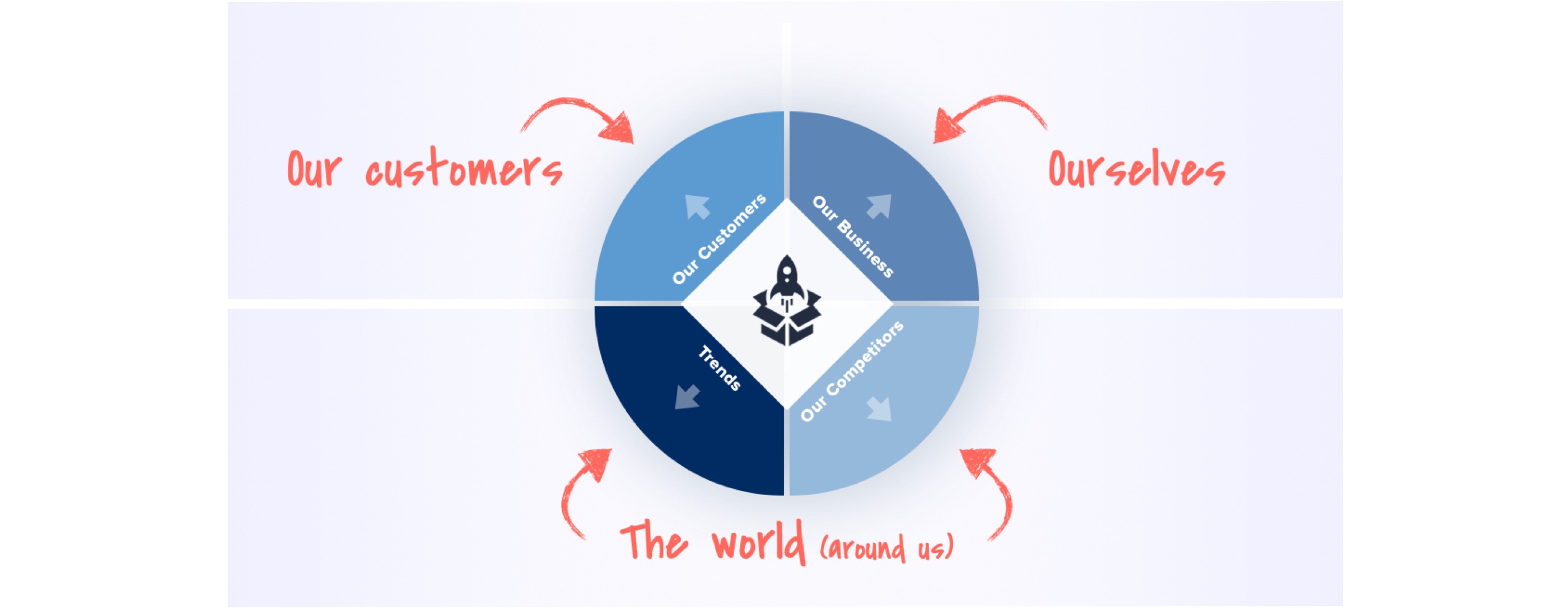
我們需要我們的客戶的理解,鄰urselves,和t 他的世界(我們周圍)。 (We need an understanding of our customers, ourselves, and the world (around us).)
Our customers (or your clients customers)— Customer demographics, their goals, needs & drivers, their behaviors & preferences, etc…
我們的客戶(或您的客戶客戶) -客戶人口統計,他們的目標,需求和驅動因素,他們的行為和偏好等…
Ourselves (your company or client) — Mission, vision, strategy & goals, business model & revenue sources, products & services, etc…
我們自己(您的公司或客戶) —使命,愿景,戰略和目標,業務模型和收入來源,產品和服務等…
The world (around your company or client) — The competitive landscape, external forces & trends (industry trends, technology trends, changing customer preferences, etc…)
世界(圍繞公司或客戶) —競爭格局,外部力量和趨勢(行業趨勢,技術趨勢,不斷變化的客戶喜好等)
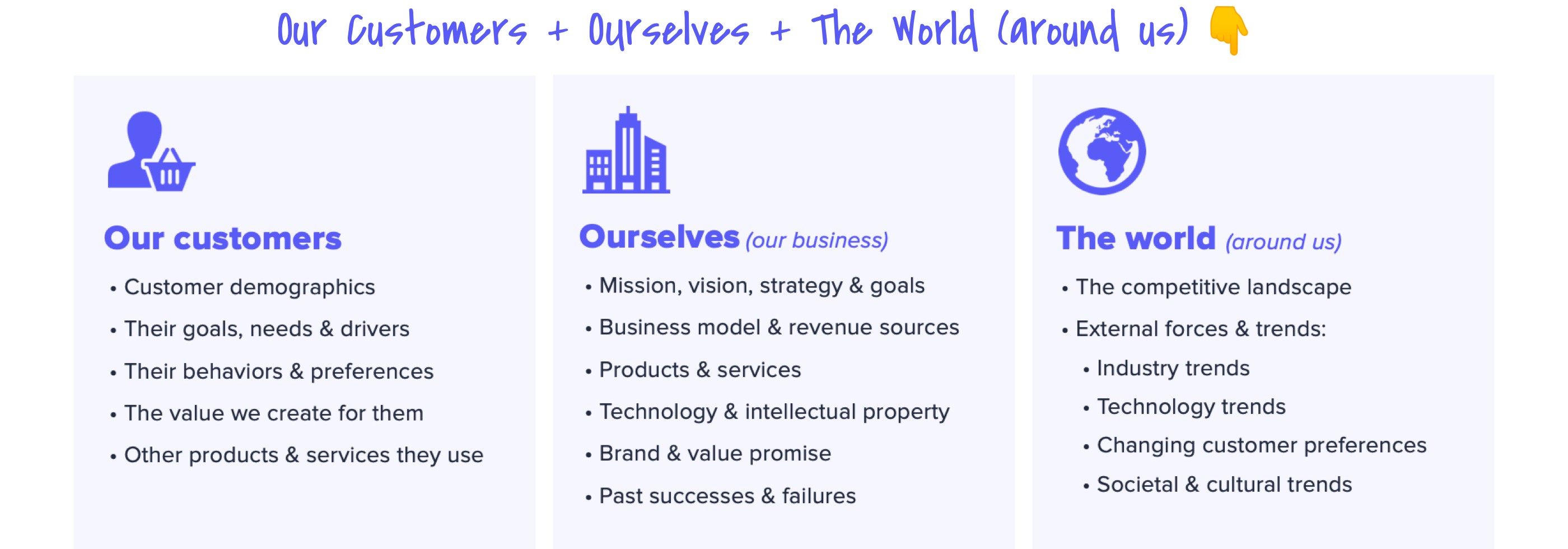
360°的理解涉及深入研究內部和外部景觀的元素。 (A 360° understanding involves looking deeply at elements of both the internal and external landscape.)
Evaluating ourselves + other brands.
評估自己+其他品牌。
Internal: Ourselves — your company or client
內部:我們自己-您的公司或客戶
External: Others — the competitive space
外部:其他-競爭空間

360°的理解使我們擁有促進影響力和一致性的知識。 (A 360° understanding empowers us with knowledge that fosters Impact and Alignment.)
A 360° understanding = Impact + Alignment
360°理解= 沖擊 + 對齊

360°理解=影響。 (A 360° understanding = Impact.)
With a 360° understanding, we empower ourselves with the knowledge to develop significantly more impactful and differentiating human-centered design solutions.
有了360°的理解,我們就能憑借自己的知識來開發更具影響力和差異化的以人為本的設計解決方案。
這些知識使我們能夠: (This knowledge empowers us to:)
Speak the language — Develop an informed perspective that speaks to both user needs and business drivers. Evangelize, discuss, and debate potential design solutions with context and clarity.
講語言 -建立一個既能了解用戶需求又能滿足業務驅動力的明智見解。 在上下文和清晰的背景下傳播,討論和辯論潛在的設計解決方案。
Strive for differentiation — Avoid ‘me-too’ features and design beyond the status quo. Develop ideas that are aligned with the needs, pain points, and aspirations of our users.
力求差異化 —避免“ me-too”功能和設計超出現狀。 提出與用戶需求,痛點和期望相一致的想法。
360°理解=對齊。 (A 360° understanding = Alignment.)
With a 360° understanding, we empower ourselves to be more strategic by aligning design thinking and decision-making with the needs, goals and priorities of the business.
通過360°理解,我們使設計思維和決策與業務的需求,目標和優先事項保持一致,從而使自己更具戰略性。
這種一致性促進了與以下方面的更牢固的伙伴關系: (This alignment fosters stronger partnerships with:)
- Customers & end-users 客戶和最終用戶
- Business leadership & executives 業務領導和高管
- Product management 產品管理
- Engineering 工程
- Sales & marketing 銷售與市場營銷
- Others within your organization 組織中的其他人

形成360°理解。 (Forming a 360° understanding.)
We can understand a company, product or service using Analysis Variables.
我們可以使用分析變量來了解公司,產品或服務。
分析變量可用于了解我們自己(內部)和其他公司(外部) 。 (Analysis Variables can be utilized to understand ourselves (internal) and other companies (external).)
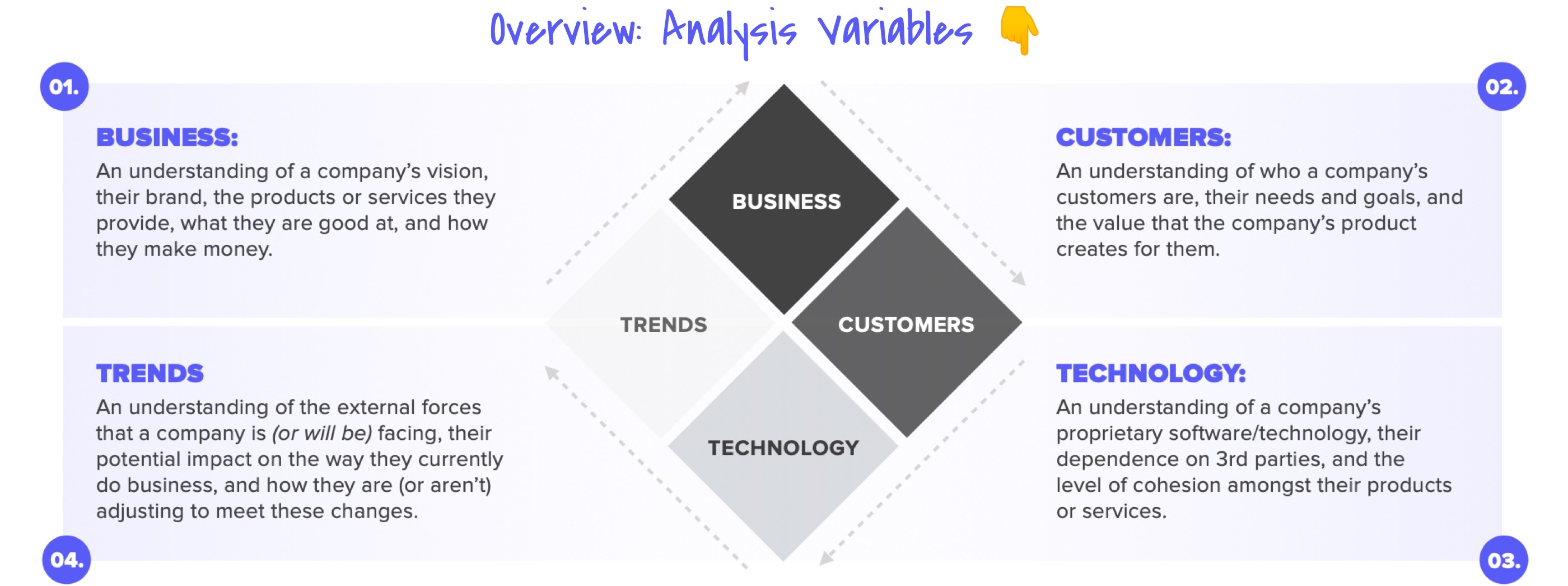
這四個變量的輸出將使我們對公司,產品或服務有透徹的了解。 (The output of these four Variables will provide us with a thorough understanding of a company, product or service.)
Business + Customers + Technology + Trends.
業務+客戶+技術+趨勢。
01: Business — A company’s vision, their brand, the products or services they provide, what they are good at, and how they make money.
01:業務 —公司的愿景,品牌,提供的產品或服務,擅長的領域以及賺錢的方式。
02: Customers — Who a company’s customers are, their needs and goals, and the value that the company’s product creates for them.
02:客戶 —公司客戶的身份,他們的需求和目標以及公司產品為他們創造的價值。
03: Technology — A company’s proprietary software/technology, their dependence on 3rd parties, and the level of cohesion amongst their products or services.
03:技術 —公司的專有軟件/技術,對第三方的依賴以及產品或服務之間的凝聚力水平。
04: Trends — The external forces that a company is (or will be) facing, their potential impact on the way they currently do business, and how they are (or aren’t) adjusting to meet these changes.
04:趨勢 -公司正在(或將要)面臨的外部力量,它們對當前開展業務方式的潛在影響以及如何(或不)進行調整以適應這些變化。
通過對多家公司(和我們自己)的分析,我們可以更好地了解環境并獲得360度的了解。 (Through an analysis of multiple companies (and ourselves), we can better understand the landscape and gain a 360° understanding.)
After using Analysis Variables to understand ourselves, other companies, and the world around us, we can use our insights and newly found understanding of the landscape to formulate a 360° understanding.
在使用分析變量了解自己,其他公司以及我們周圍的世界之后,我們可以使用我們的洞察力和新發現的對地形的理解來形成360°的理解。


進行分析。 (Conducting an analysis.)
Analysis Variables can be used to guide our analysis.
分析變量可用于指導我們的分析。

對于每個變量,我們都可以使用分析技術。 (For each variable, there are analysis techniques that we can utilize.)
Some are good for internal analysis, others for external — some can be executed independently, others require the participation of others.
有些適合內部分析,有些適合外部分析-有些可以獨立執行,有些需要其他人的參與。


分析變量01-分析業務。 (Analysis Variable 01 — analyzing a business.)
Analyzing a business will help us understand a company’s vision, their brand values and positioning, the products or services they provide, what they are good at, and how they make money.
分析業務將幫助我們了解公司的愿景,品牌價值和定位,提供的產品或服務,擅長的領域以及賺錢的方式。
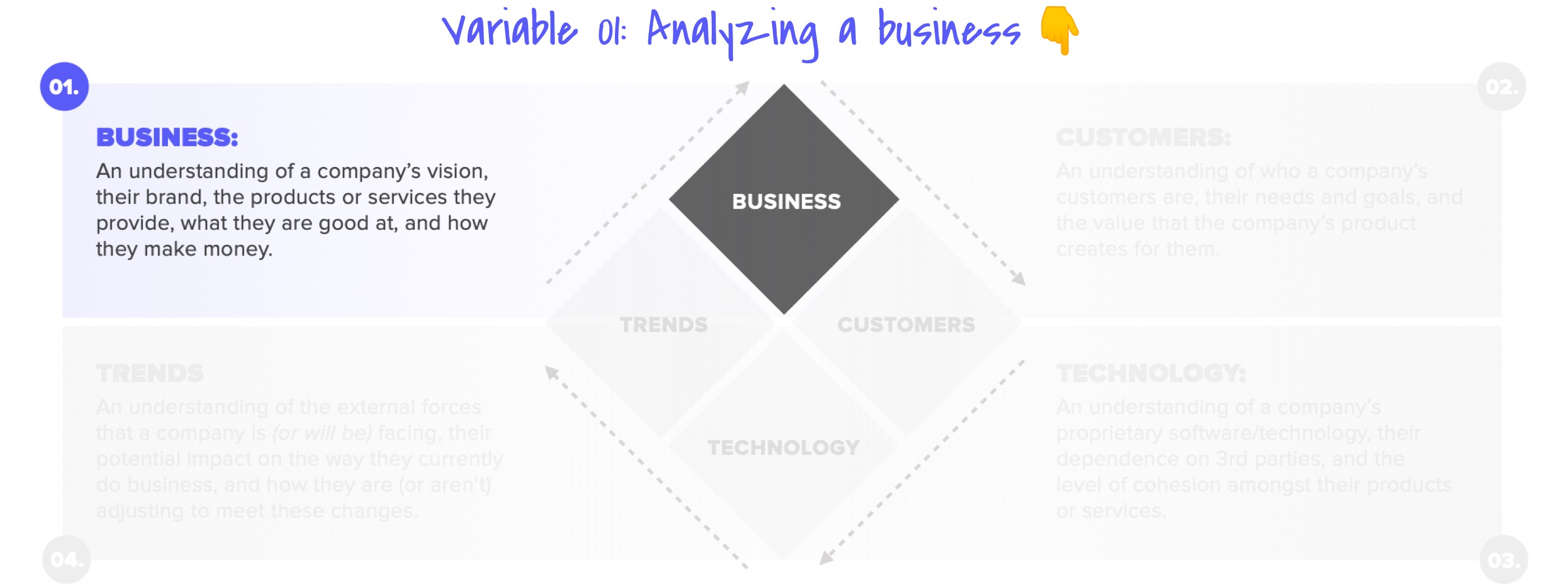
分析業務時,我們可以專注于公司,公司的一項或多項產品和服務,或兩者兼而有之。 (When analyzing a business, we can focus on a company, one or more of its products & services, or both.)

分析公司。 (Analyzing a company.)
By analyzing a company, we can understand their vision, brand and value promise, their business model, how they make money, and where they have been successful and fell short in the past.
通過分析公司,我們可以了解他們的愿景,品牌和價值承諾,他們的商業模式,他們如何賺錢以及他們過去成功的地方和失敗的地方。
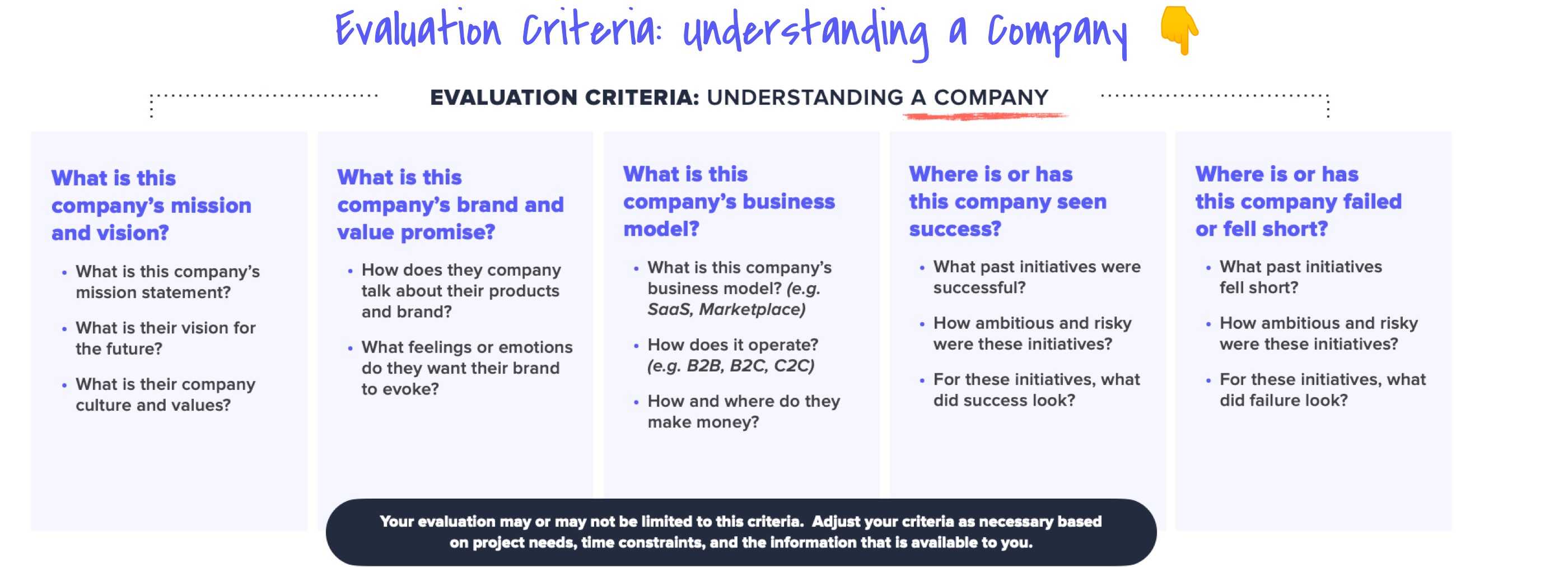
分析公司的產品。 (Analyzing a company’s products.)
By analyzing a company’s products, we can understand the products or services they provide, how they fit into a larger portfolio, their selling points and market positioning, future aspirations, and their competition.
通過分析公司的產品,我們可以了解他們提供的產品或服務,它們如何適合更大的產品組合,它們的賣點和市場定位,未來的抱負以及競爭。
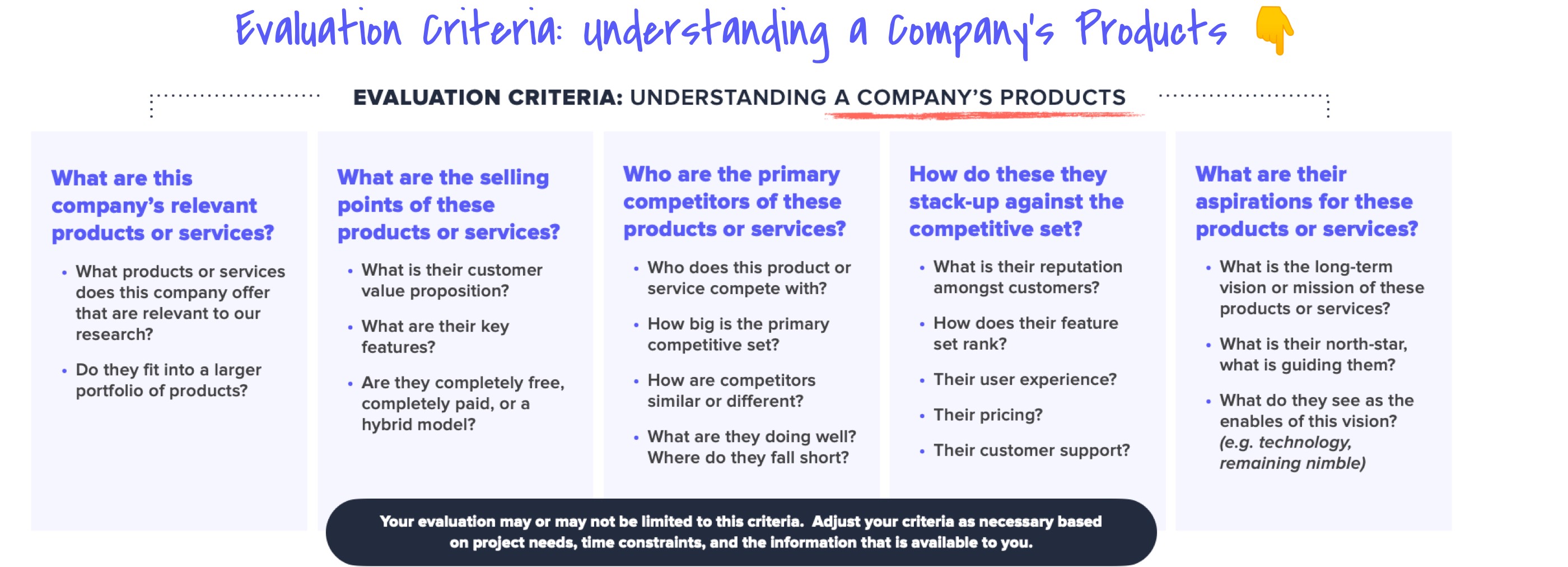
要分析公司及其產品和服務,我們可以采用多種工具和技術。 (To analyze a company and its products & services, we can employ a variety of tools and techniques.)
Some are good for internal analysis, others for external — some can be executed independently, others require the participation of others.
有些適合內部分析,有些適合外部分析-有些可以獨立執行,有些需要其他人的參與。
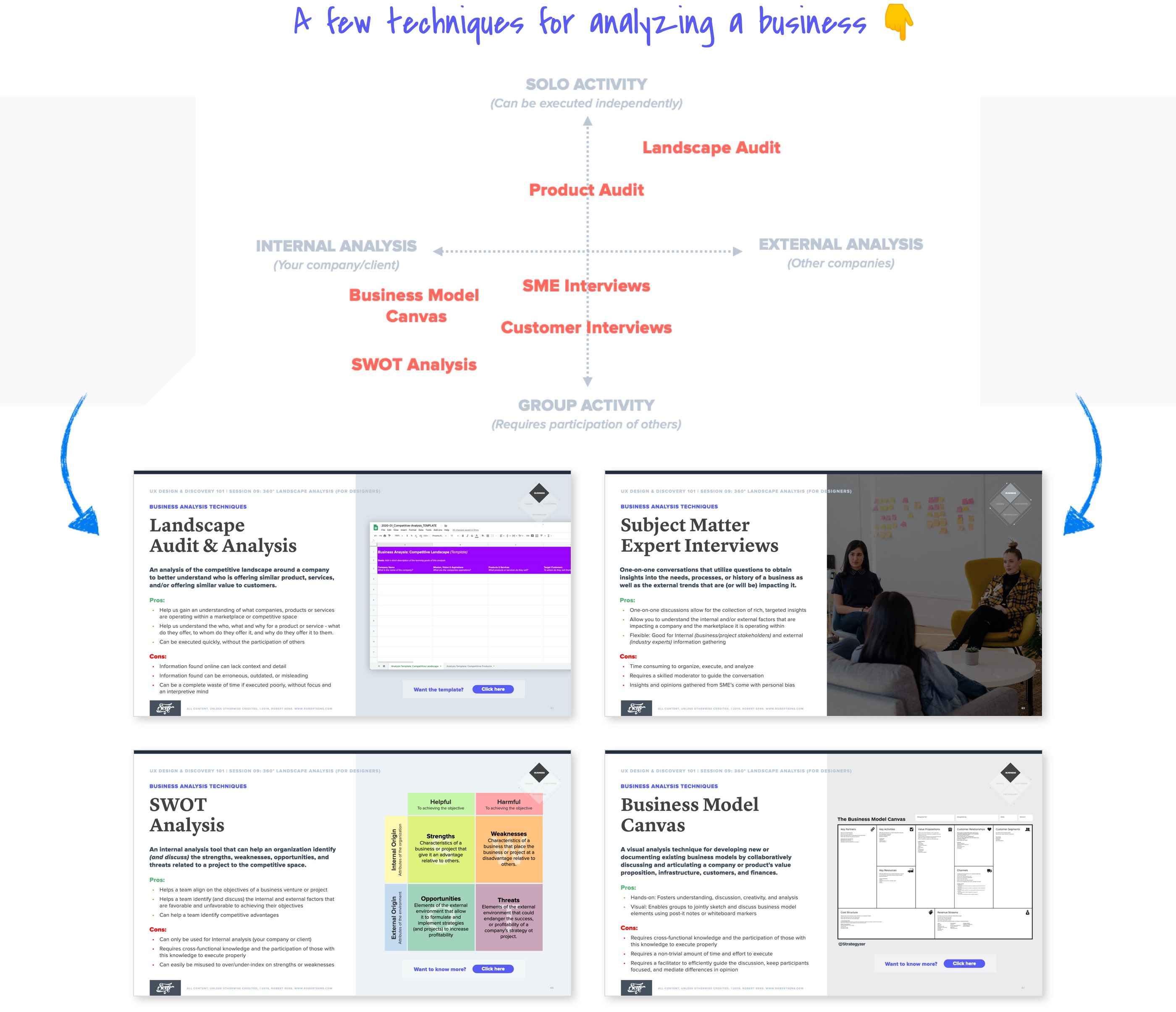
但是,在開始進行分析之前,我們需要了解業務模型的基礎。 (However, before getting started with our analysis, we need to understand the basics of Business Models.)
A business model is a company’s plan for making a profit. It identifies the products or services the business will sell, the target market it has identified, and the expenses associates with operating.
商業模式是公司的獲利計劃。 它確定企業將要出售的產品或服務,確定的目標市場以及與運營相關的費用。
What is being sold — The products or services this business offer to its customers.
正在出售的產品-該企業向其客戶提供的產品或服務。
Who it is being sold to — The target customers of the products or services the company offers.
將其出售給誰 —公司提供的產品或服務的目標客戶。
Operational expenses — The costs associated with the company’s business operations.
運營支出 -與公司業務運營相關的成本。
在進行分析以獲取360°理解時,我們主要關注與公司價值主張相關的業務模型方面。 (When analyzing to gain a 360° understanding, we are primarily concerned with the aspects of the Business Model that speak to a company’s Value Proposition.)

要了解公司的商業模式,包括其價值主張,我們可以從回答五個問題開始。 (To understand a company’s Business Model, including their Value Proposition, we can start by answering five questions.)

要回答這五個問題,我們需要了解企業的??基本知識及其運作方式。 (To answer these five questions, we need to understand the basics of a business and how they operate.)
In most cases, to answer these five questions and understand a company, we can analyze publicly available information.
在大多數情況下,要回答這五個問題并了解一家公司,我們可以分析公開可用的信息。
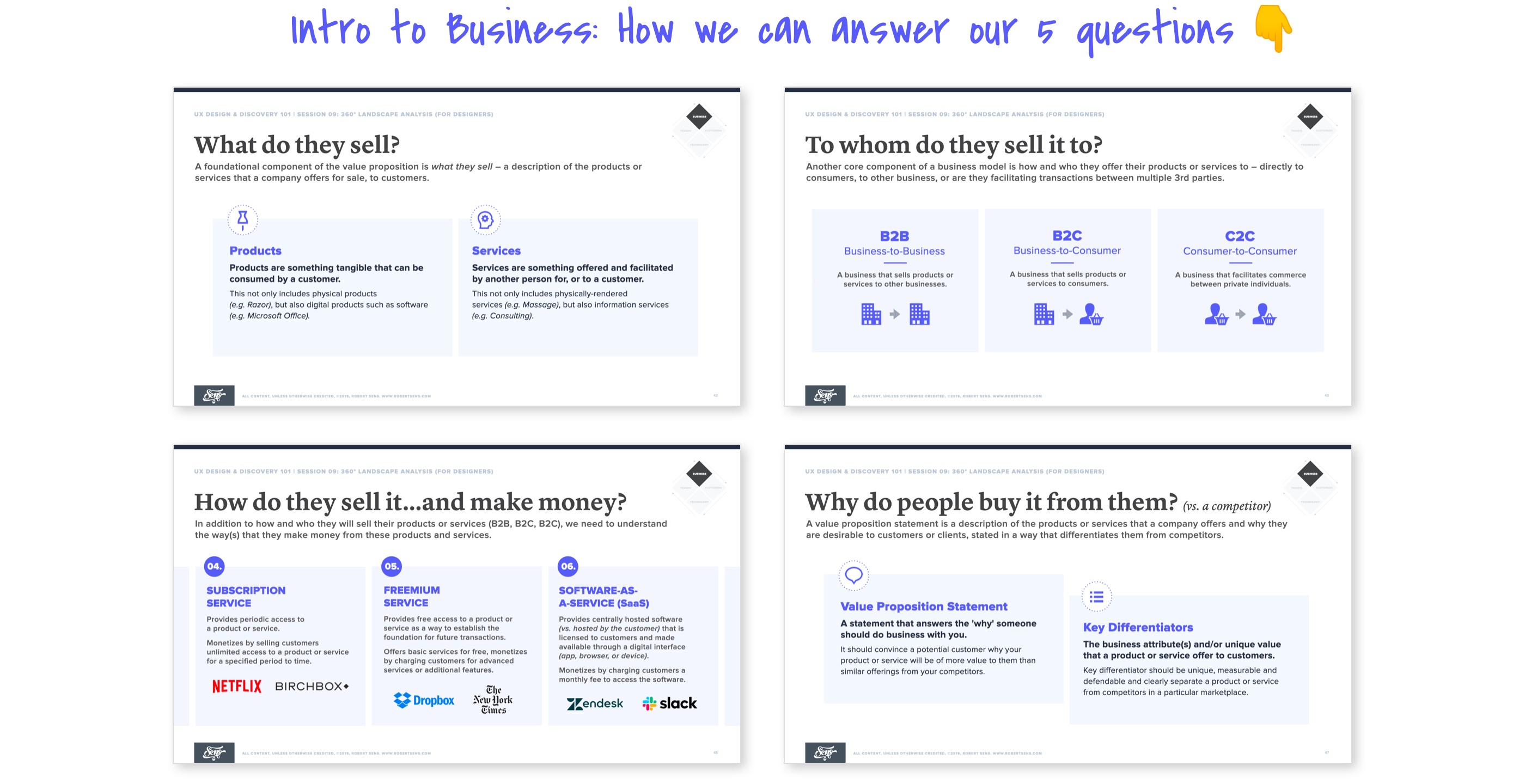

分析變量02-分析客戶。 (Analysis Variable 02 — analyzing customers.)
Analyzing customers will help us understand who a company’s customers are, their needs & goals, how they behave, the value that a company’s product creates for them, and other similar products or services that they utilize.
分析客戶將幫助我們了解公司的客戶是誰,他們的需求和目標,他們的行為方式,公司產品為他們創造的價值以及他們使用的其他類似產品或服務。
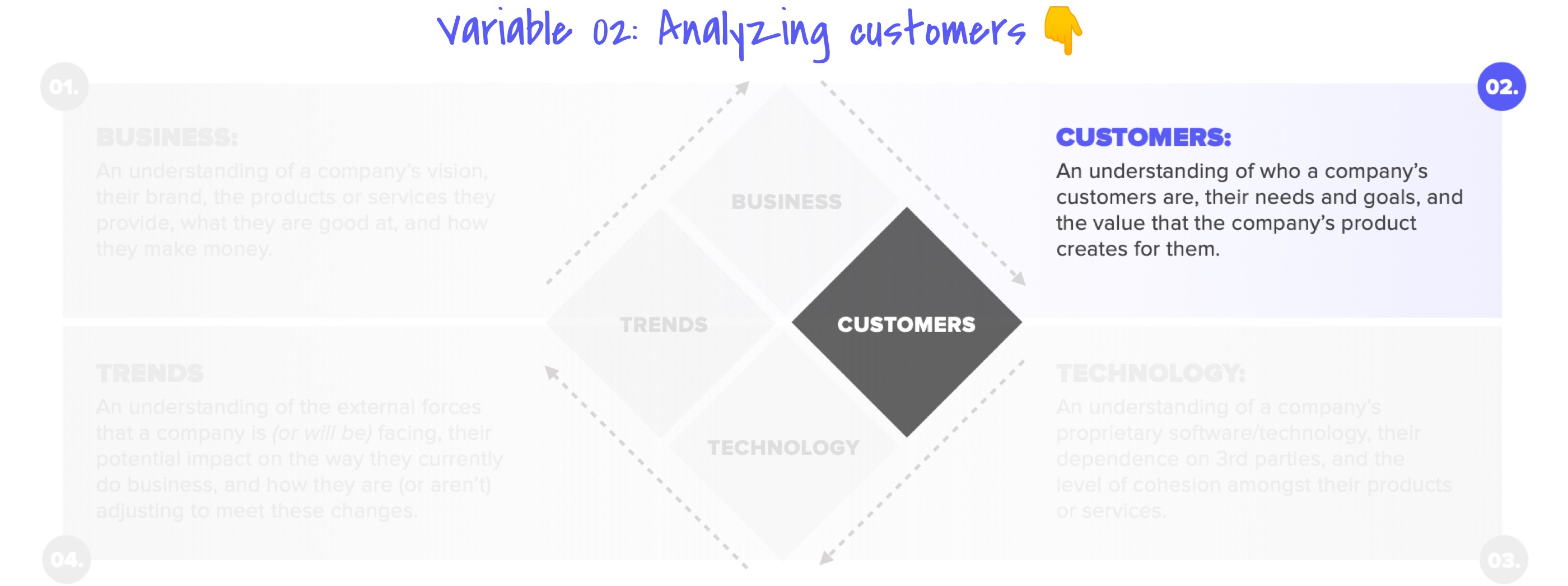
分析公司的客戶。 (Analyzing a company’s customers.)
By analyzing a company’s customers, we can understand what types of customer they are targeting and why.
通過分析公司的客戶,我們可以了解他們針對的客戶類型以及原因。
Additionally, we can gain an understanding of why customers use the company’s products — including what needs the company’s products are helping them fulfill, how they interact with the product, what value they obtain from using the product, and what (if any) other products they use to fulfill similar needs.
此外,我們還可以了解客戶為何使用公司的產品-包括公司的產品正在幫助他們滿足哪些需求,他們如何與產品互動,從使用產品中獲得什么價值以及什么(如果有)其他產品。他們用來滿足類似的需求。
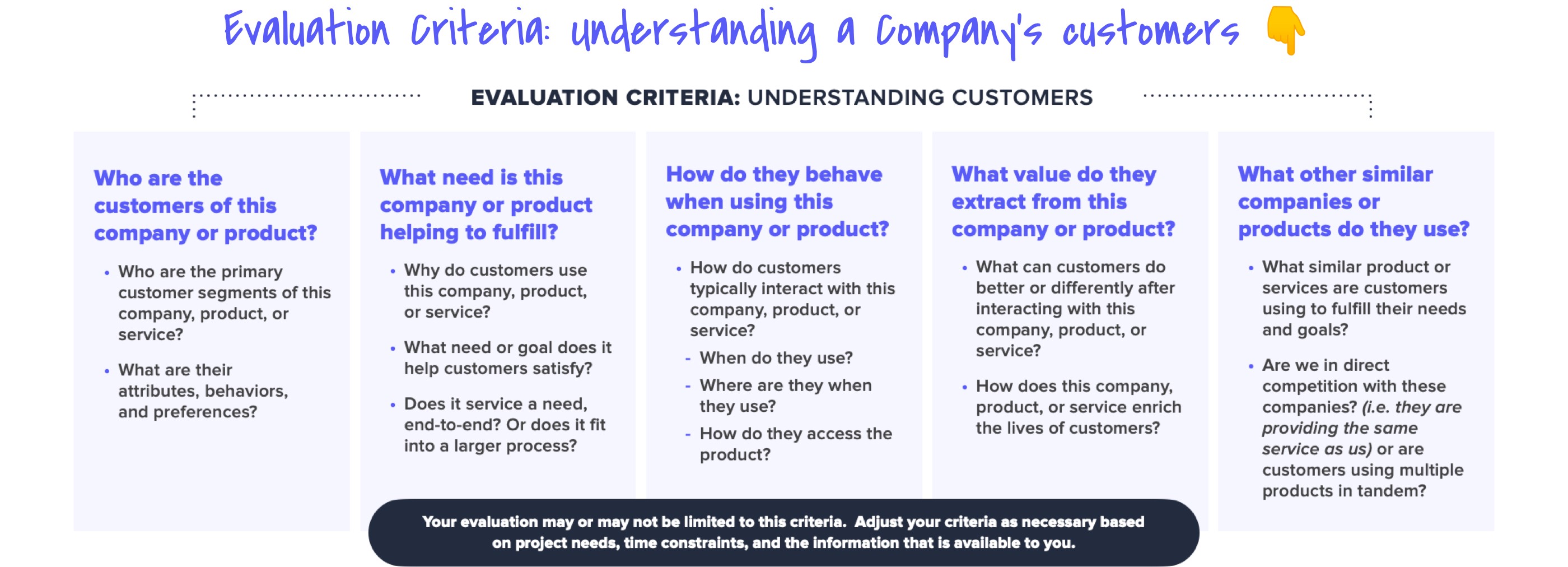
要分析公司的客戶,我們可以采用多種工具和技術。 (To analyze a company’s customers, we can employ a variety of tools and techniques.)
Some are good for internal analysis, others for external — some can be executed independently, others require the participation of others.
有些適合內部分析,有些適合外部分析-有些可以獨立執行,有些需要其他人的參與。
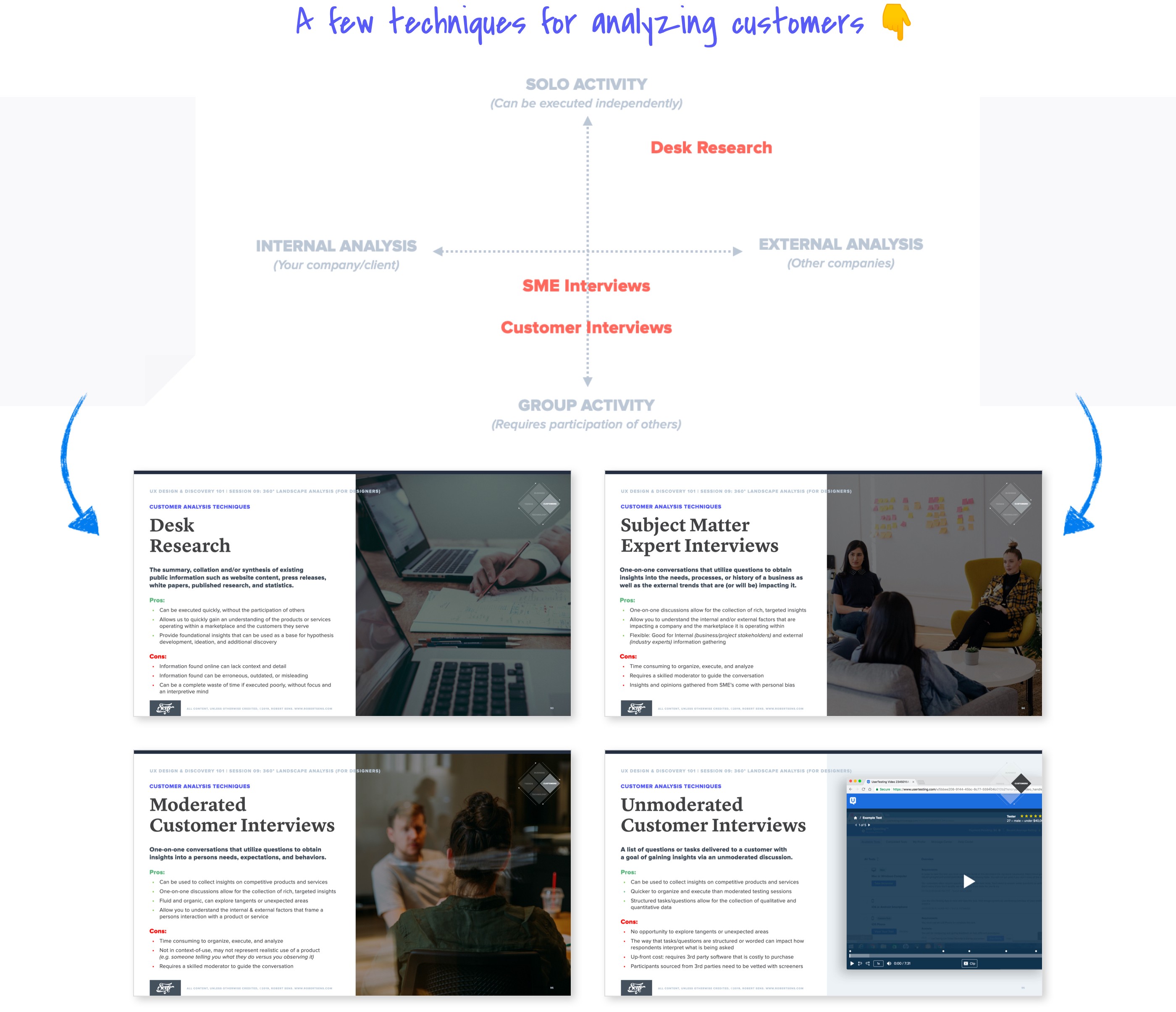
但是,在開始進行分析之前,我們需要了解客戶群的基礎。 (However, before getting started with our analysis, we need to understand the basics of Customer Segments.)
Customer Segments are sub-groups of customers, segmented by some type of shared characteristics, that a product or service has identified as being most likely to have high growth and profit potential.
客戶群是按某種共有特征細分的客戶子群,產品或服務已被確定為最有可能具有高增長和潛在利潤。
Geographic — Country, city area/region, population, etc…
地理 -國家,城市地區/區域,人口等…
Demographic — Age, gender, income, life stage, etc…
人口特性 -年齡,性別,收入,生活階段等…
Behavioral — Intent, usage, benefits sought, buyer stage, etc…
行為 -意圖,用法,尋求的利益,購買者階段等…
Psychographic — Lifestyle, activities/interests/opinions (AIO), values, attitudes, etc…
心理記錄 -生活方式,活動/興趣/意見(AIO),價值觀,態度等…

公司的商業模式,包括他們銷售的產品和銷售方式,通常會對他們選擇細分客戶的方式產生重大影響。 (A company’s business model, including the products they sell and the way they sell them, typically has a significant impact on the way that they choose to segment their customers.)
- Business-to-business (B2B) sellers might segment the market into different types of businesses or by countries/regions. 企業對企業(B2B)賣方可能會將市場劃分為不同類型的企業或按國家/地區劃分。
- Business-to-consumer (B2C) sellers might segment the market into demographic, lifestyle or behavioral segments. 企業對消費者(B2C)賣家可能會將市場細分為人口,生活方式或行為細分。

單個堿基通常用于細分。 但是,可以將某些堿基合并為一個細分(小心)。 (A single base is typically used for segmentation. However, some bases can be combined into a single segmentation (with care).)
For example, geographics and demographics (geo-demographic) are often combined, but others combinations are less common.
例如,地理和人口統計(地域人口統計)通常會組合在一起,但其他組合則不太常見。


分析變量03-分析技術。 (Analysis Variable 03 — analyzing technology.)
Analyzing technology will help us understand a company’s software and technology prowess, their dependence on 3rd parties, the level of cohesion amongst their products, and if technology roadblocks or efficiencies exist within the company.
分析技術將幫助我們了解公司的軟件和技術實力,他們對第三方的依賴,產品之間的凝聚力以及公司內是否存在技術障礙或效率。
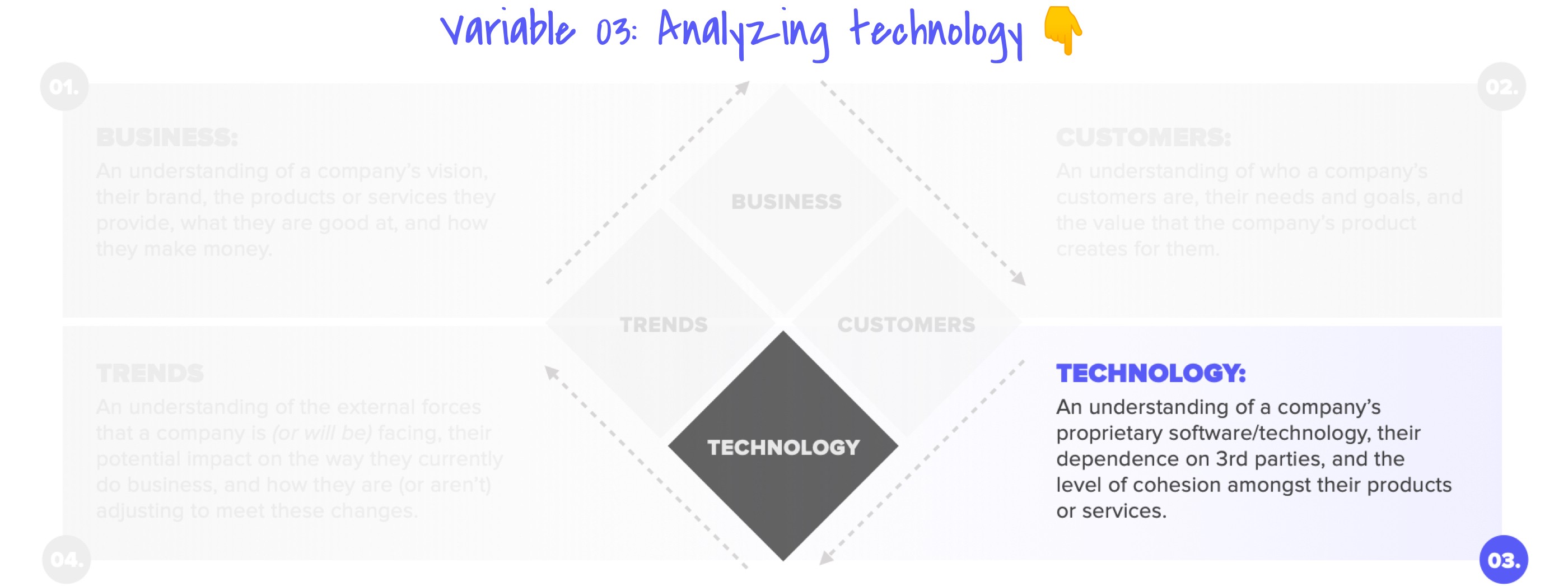
分析公司的技術。 (Analyzing a company’s technology.)
By analyzing a company’s technology, we can understand how well suited they are to be able to build digital products and services.
通過分析公司的技術,我們可以了解他們對于構建數字產品和服務的適合程度。
The most common factors that can influence a company’s ability to build digital products and services include their history and relationship with technology (how embedded is technology in their DNA?), how dependent they are on 3rd party technology providers, the existing level of cohesion amongst their product’s technology, and the roadblocks or efficiencies that exist as a result of this level of cohesion.
影響公司構建數字產品和服務能力的最常見因素包括其歷史和與技術的關系(技術在其DNA中的嵌入程度如何) ,它們對第三方技術提供商的依賴程度,現有的凝聚力水平他們產品的技術,以及由于這種凝聚力而存在的障礙或效率。
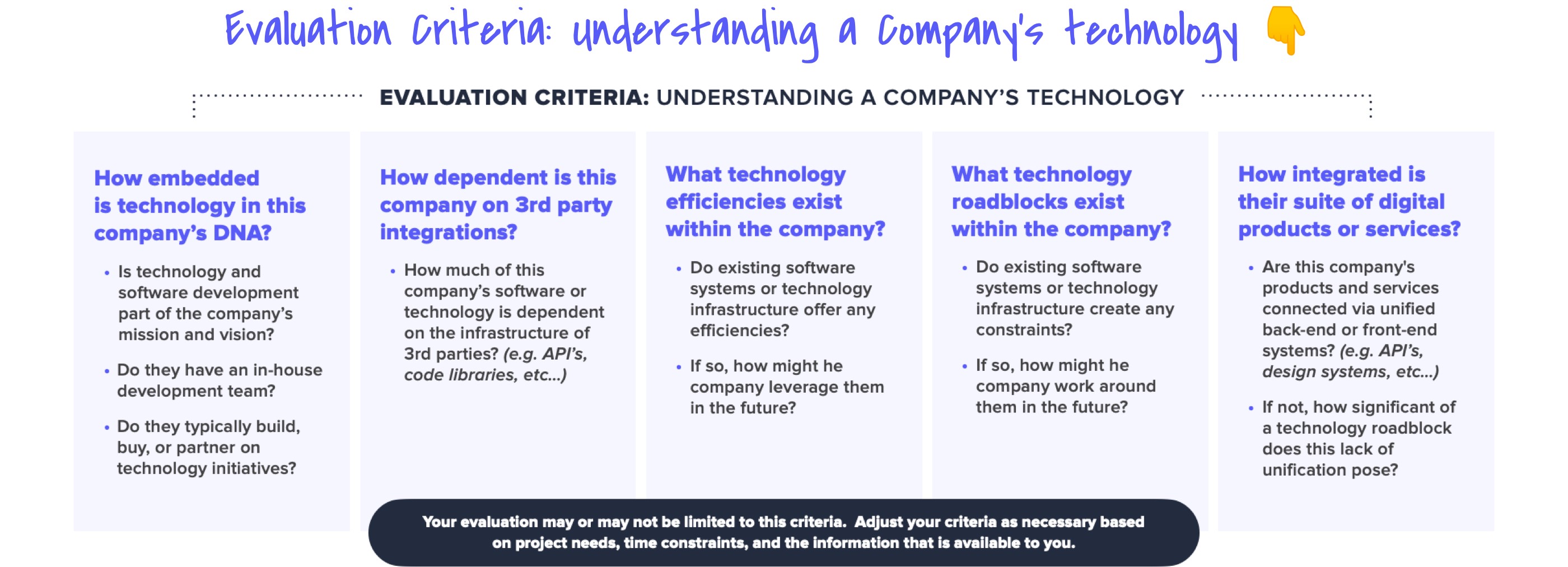
要分析公司的技術,我們可以采用一些不同的工具和技術。 (To analyze a company’s technology, we can employ a few different tools and techniques.)
Some are good for internal analysis, others for external — some can be executed independently, others require the participation of others.
有些適合內部分析,有些適合外部分析-有些可以獨立執行,有些需要其他人的參與。
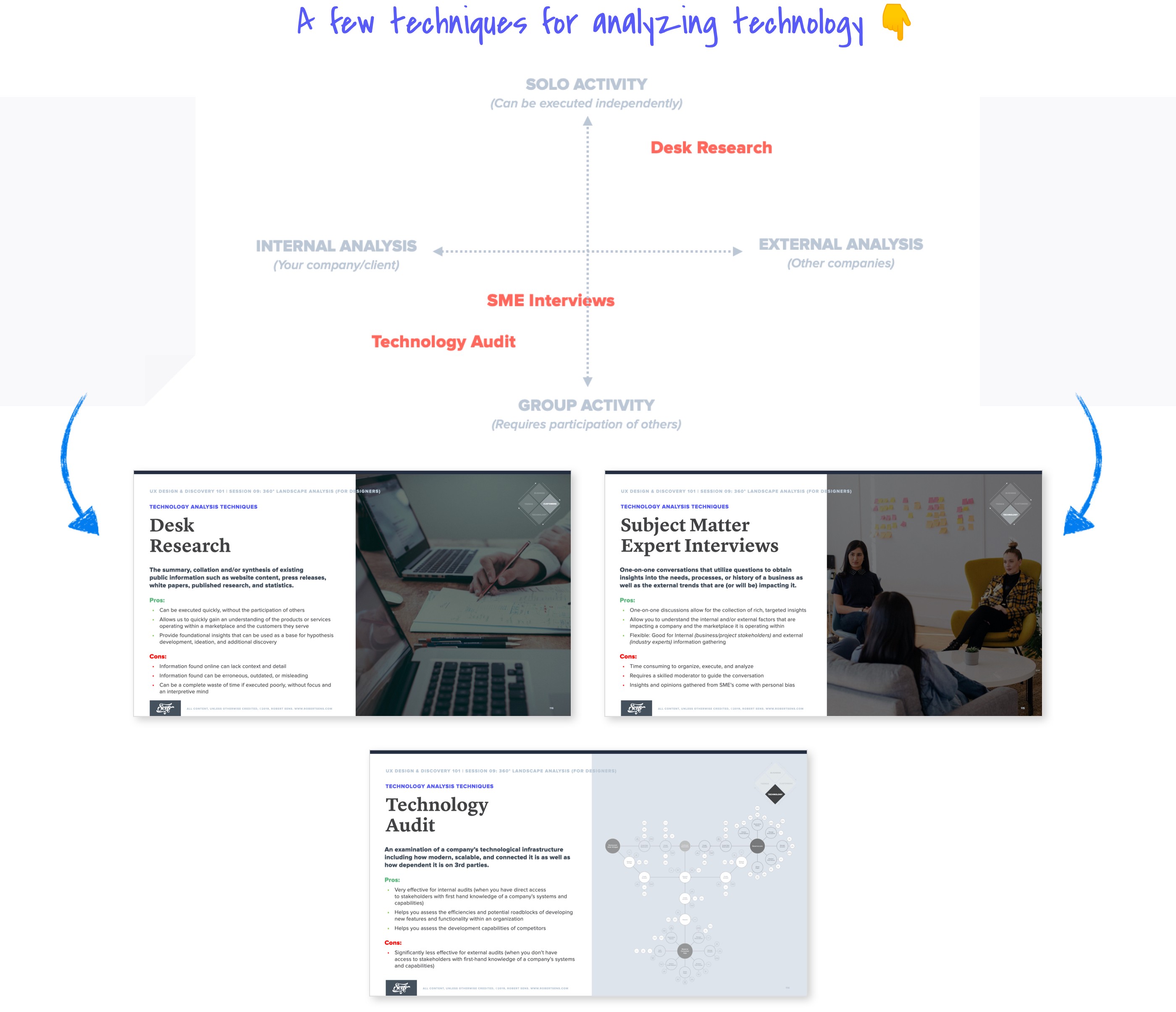
分析公司的技術基礎結構時,重要的是要考慮三個變量。 (When analyzing a companies technological infrastructure, it is important to consider three variables.)
Existing infrastructure — How modern, scalable, and connected is the company’s technological infrastructure?
現有的基礎架構 -公司的技術基礎架構如何現代化,可擴展和相互連接?
Dependency on others — How dependent is the company on 3rd party software to power their existing infrastructure?
對他人的依賴-公司對第三方軟件的依賴程度如何,以支持其現有基礎架構?
Ability to build — Is the company capable of building software internally to power their own infrastructure?
構建能力 -公司是否有能力在內部構建軟件以為其自身的基礎架構提供動力?


分析變量04-分析趨勢。 (Analysis Variable 04 — analyzing trends.)
Evaluating trends will help us understand the external forces that a company is (or will be) facing, their potential impact on the way they currently do business, and how they are (or aren’t) adjusting to meet these changes.
評估趨勢將有助于我們了解公司正在(或將要面臨)的外部力量,它們對當前經營方式的潛在影響以及如何(或不)進行調整以適應這些變化。
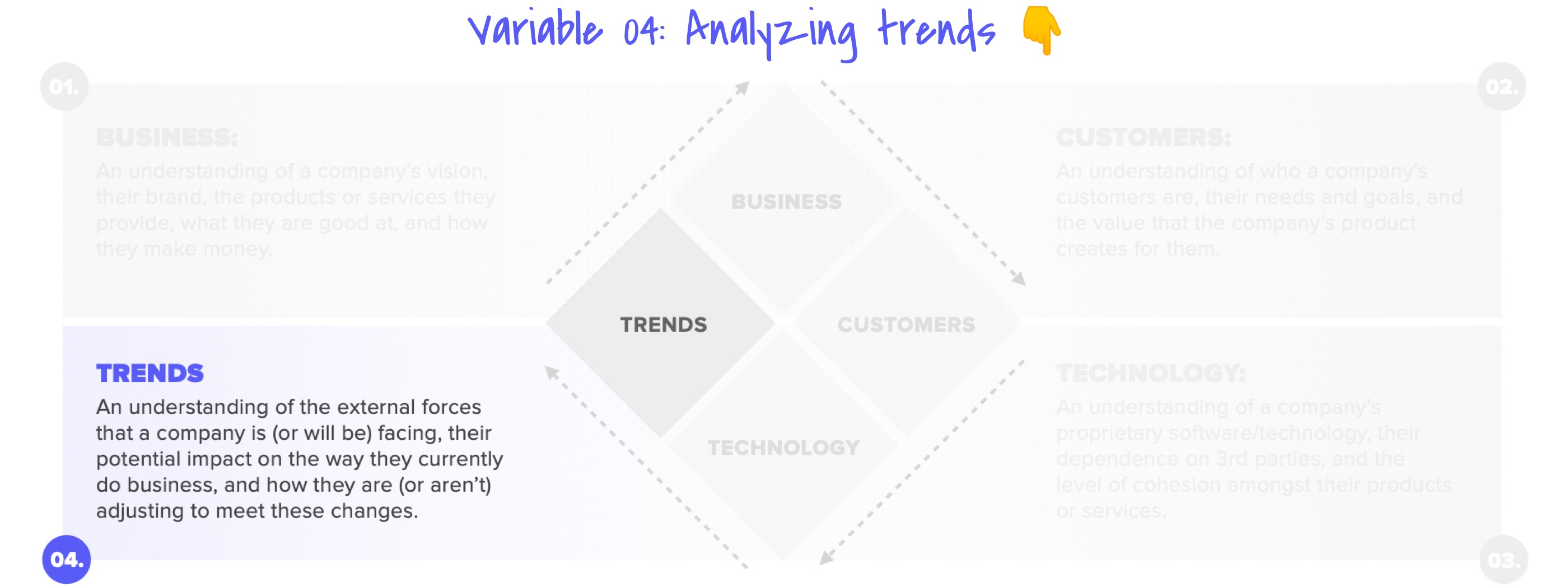
分析影響公司的趨勢和外部力量。 (Analyzing the trends & external forces impacting a company.)
By analyzing trends and external forces, we can understand the headwinds that a company is (or will be) facing and how they could, are, or aren’t adjusting to meet these changes.
通過分析趨勢和外部力量,我們可以了解公司正在(或將要面對)的不利因素以及它們如何,正在或不能夠適應這些變化。
To gain an understanding of the external forces, we need to analyze external trends and upstart competitors, the risks they pose to a company, and what (if any) actions the company is taking to address these risks.
為了了解外部力量,我們需要分析外部趨勢和新貴競爭對手,競爭對手給公司帶來的風險以及公司為應對這些風險所采取的行動(如果有) 。
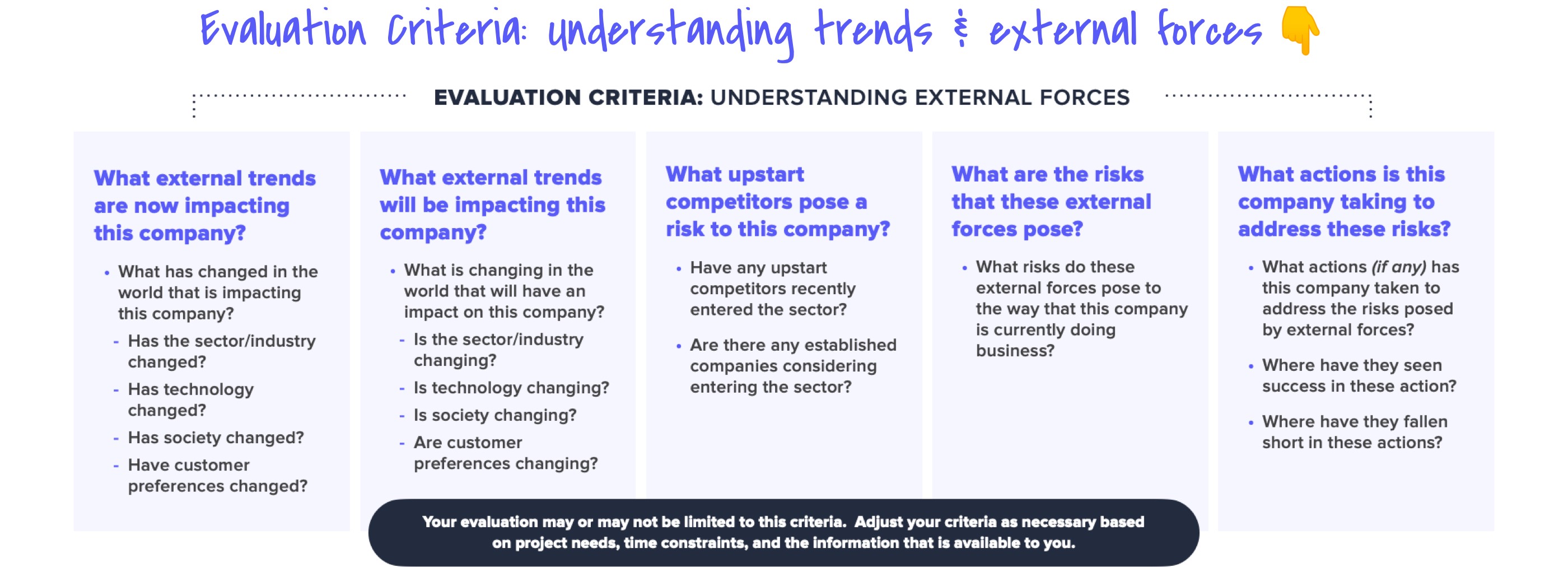
為了分析影響公司的趨勢和外部力量,我們可以采用一些不同的工具和技術。 (To analyze the trends & external forces impacting a company, we can employ a few different tools and techniques.)
Some are good for internal analysis, others for external — some can be executed independently, others require the participation of others.
有些適合內部分析,有些適合外部分析-有些可以獨立執行,有些需要其他人的參與。
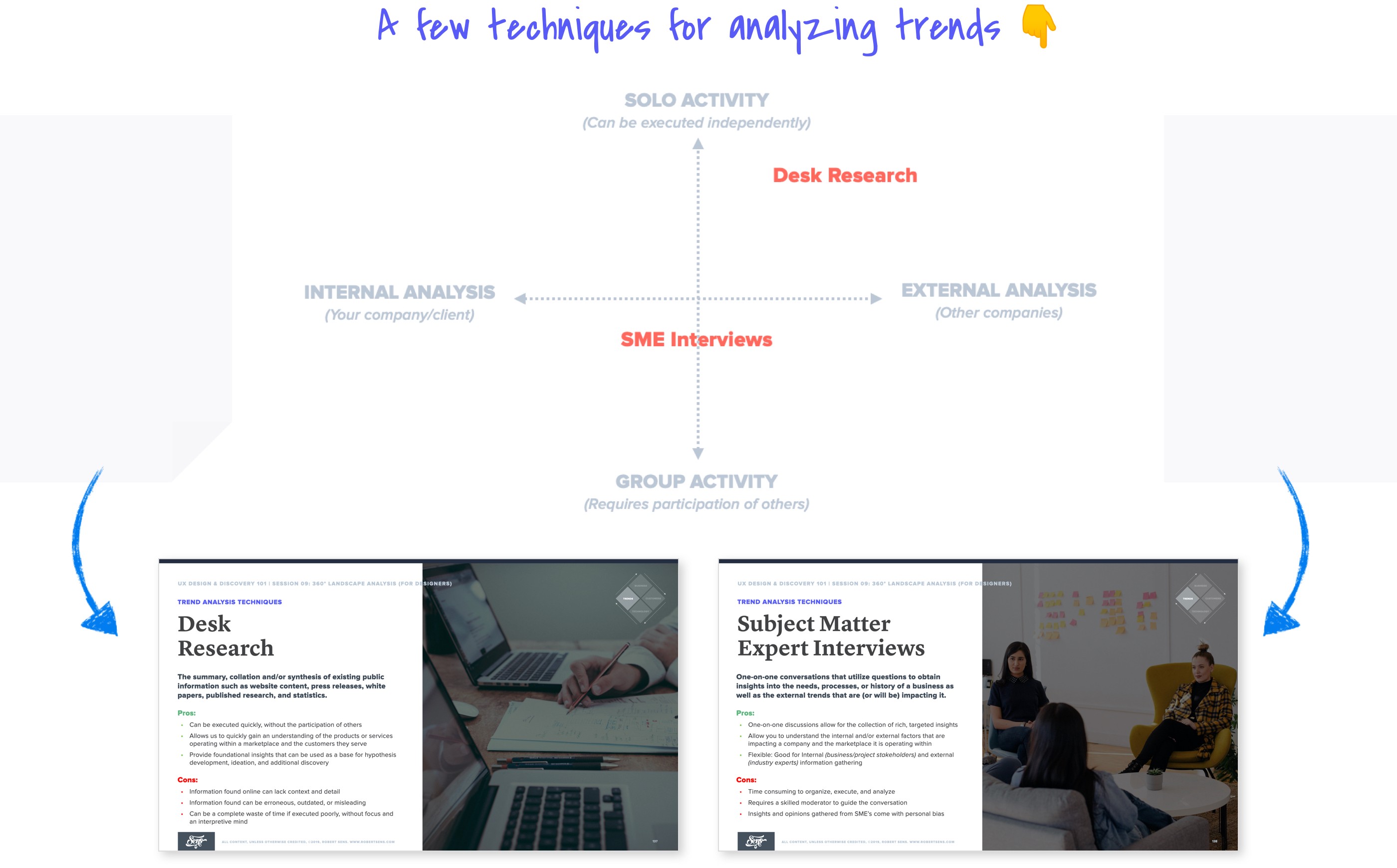
行業,技術和社會是影響產品或服務的最常見外部趨勢類型。 (Industry, technology and societal are the most common types of external trends that impact a product or service.)
Industry trends — Changes impacting an industry, sector, or market.
行業趨勢 -影響行業,行業或市場的變化。
Technology trends—Changes in technology and human-computer interaction.
技術趨勢 -技術和人機交互的變化。
Societal trends—Trends in human behavior, perception, or expectations.
社會趨勢 -人類行為,感知或期望的趨勢。

來自行業領導者的白皮書通常是有關行業趨勢的絕佳信息來源。 (White papers from industry leaders are often excellent sources of information on industry trends.)
Companies, consultancies and agencies are continuously publishing white papers and articles on the trends impacting industry sectors. These types of resources provide a wealth of free information.
公司,咨詢公司和代理商不斷發布有關影響行業的趨勢的白皮書和文章。 這些類型的資源提供了大量的免費信息。
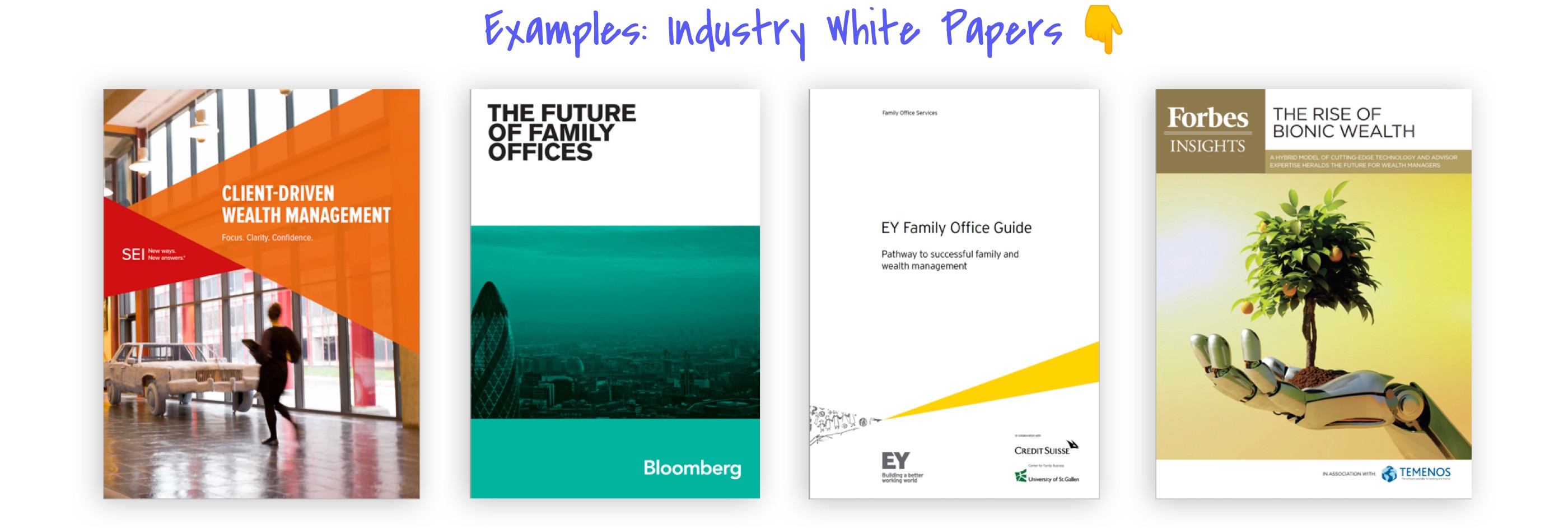
設計機構和創新咨詢公司的年度趨勢報告是有關技術和社會趨勢的絕佳信息來源。 (Annual trend reports from design agencies and innovation consultancies are excellent sources of information on technology & societal trends.)
Each year, agencies and innovation consultancies like Fjord and frog publish their take on the technological and societal shifts impacting their clients. These types of resources provide a wealth of free information.
每年,諸如峽灣和青蛙之類的代理機構和創新咨詢公司都會發布影響客戶的技術和社會變革報告。 這些類型的資源提供了大量的免費信息。


本次會議如何安排和促進? (How is this session structured & facilitated?)
This session is a mix of theory and short, hands-on activities that enable participants to apply concepts in real-time.
本次會議結合了理論和簡短的動手操作,使參與者能夠實時應用概念。
Participants are first walked through the value of having a 360° understanding, what it entails, and the four Analysis Variables that can be used to establish a 360° understanding. They are then walked through each variable individually and introduced to what they need to know before they get started, analysis techniques they can utilize, and a real-world example of how they can start small to get an analysis up and running quickly.
首先,參與者了解了對360°理解的價值,所包含的內容以及可用于建立360°理解的四個分析變量。 然后,他們分別瀏覽每個變量,并向他們介紹開始之前需要了解的知識,可以利用的分析技術以及如何從小處著手以快速啟動分析和運行的真實示例。
Throughout the session, several short, hands-on exercises are used to reinforce the content.
在整個會話中,將使用一些簡短的動手練習來增強內容。
The facilitator deck & exercise structure can be reviewed below. 👇👇🏼👇🏾
主持人平臺和練習結構可以在下面進行審查。 👇👇🏼👇🏾

您如何在本課程中執行練習? (How can you execute the exercises in this lesson?)
There are four medium length, participatory exercises intertwined within the content of this session — each exercise builds upon the previous one, resulting in a lightweight analysis of a company.
在本次會議的內容中,有四個中等長度的參與性練習相互交織-每個練習都是在前一個練習的基礎上進行的,從而對公司進行了輕量級的分析。
選擇公司。 (Choosing a company.)
At the beginning of this session, participants are asked to choose a company to focus on and use throughout the four exercises. To keep things simple, I provide participants with a list of 6 companies whose product offerings are not overly complex and have plenty of information available online.
在本節開始時,要求參與者選擇一家公司,以集中精力并使用這四個練習。 為簡單起見,我為參加者提供了6家公司的列表,這些公司的產品提供并不太復雜,可以在線獲取大量信息。


練習01- 分析一家公司。 (20分鐘) (Exercise 01 — analyzing a company. (20 mins))
The goal of this exercise is to practice starting small and getting up and running quickly by conducting a simple analysis of a company using information available on the internet.
該練習的目的是通過使用Internet上可用的信息對公司進行簡單分析,練習從小規模起步,快速起步并快速運行。
In this exercise, participants are asked to analyze and identify the key attributes of a company (chosen from the list provided) using information available on the internet. To guide their analysis, they are provided a sample analysis goal and an evaluation criteria consisting of five questions.
在本練習中,要求參與者使用Internet上可用的信息來分析和識別公司的關鍵屬性(從提供的列表中選擇) 。 為了指導他們的分析,向他們提供了一個樣本分析目標和一個包含五個問題的評估標準。
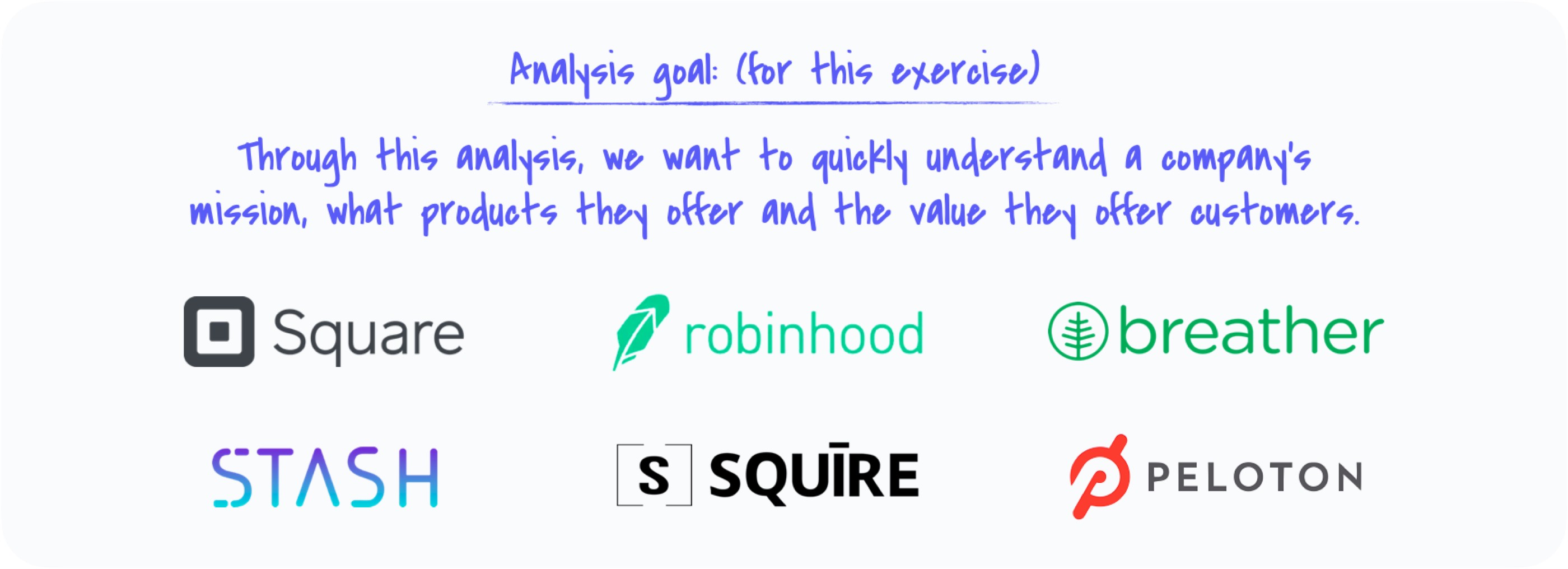
練習01:格式。 (Exercise 01: Format.)
After providing participants with an overview of Analysis Variable 01 (analyzing a business) and walking them through a real-world example of how they can start small to get up and running quickly, ask participants to practice conducting their own lightweight analysis.
向參與者提供了分析變量01的概述(分析業務)并向他們展示了如何從小處著手以快速啟動并運行的真實示例之后,請參與者練習進行自己的輕量級分析。
Using the sample Analysis Goal (above) and Evaluation Criteria (below), prompt participants to search the internet for information that can provide insights into the companies they have chosen from the list provided.
使用樣本分析目標(上方)和評估標準(下方) ,提示參與者在互聯網上搜索信息,這些信息可以深入了解他們從提供的列表中選擇的公司。
Pro-tip: Have participants start their search on the company’s ‘About’ page, usually a link in the footer of their website.
專家提示:讓參加者在公司的“關于”頁面上開始搜索,通常在其網站頁腳中有一個鏈接。
- As they find information that is relevant to the five questions in the evaluation criteria, instruct them to take screenshots and write down key points on a piece of paper or post-it notes. 當他們找到與評估標準中的五個問題相關的信息時,請他們進行屏幕截圖并將要點記錄在一張紙或便簽紙上。
- As they search, encourage them to also write down any questions they have about the company that arise from the information they find. Getting into this habit will help them practice critical thinking and analyzing the information they find beyond a surface level. 當他們搜索時,鼓勵他們也寫下他們從發現的信息中對公司的任何疑問。 養成這種習慣將幫助他們練習批判性思維,并分析他們從表面上發現的信息。

練習01:總結。 (Exercise 01: Wrapping-up.)
After the exercise, prompt participants to spend a few minutes sharing what they learned from conducting their analysis and what (if anything) was challenging about finding and analyzing information found on the internet.
練習后,提示參與者花幾分鐘時間分享他們從進行分析中學到的知識,以及在查找和分析在互聯網上找到的信息時面臨的挑戰(如果有的話) 。

練習02 —我確定客戶。 (15分鐘) (Exercise 02— identifying customers. (15 mins))
This exercise builds upon the previous exercise, its goal is to practice starting small and getting up and running quickly by conducting a simple analysis of who a company’s target customer(s) are using information available on the internet and the insights discovered in activity 01.
本練習是在上一個練習的基礎上進行的,其目標是通過使用網絡上的可用信息以及在活動01中發現的見解進行簡單分析,以練習從小處著手并快速啟動并運行。
In this exercise, participants are asked to identify the target customer segment(s) of the company they analyzed in activity 01. To guide their analysis, they are provided a sample analysis goal and an evaluation criteria that builds upon the questions from the previous activity (see below).
在本練習中,要求參與者確定他們在活動01中分析的公司的目標客戶群。為指導他們的分析,將為他們提供一個樣本分析目標和一個基于先前活動的問題的評估標準。 (請參見下文) 。

練習2:格式。 (Exercise 2: Format.)
After providing participants with an overview of Analysis Variable 02 (analyzing customers) and walking them through a real-world example of how they can start small to get up and running quickly, ask participants to practice conducting their own lightweight analysis.
向參與者提供了Analysis Variable 02的概述(分析客戶)并向他們展示了如何從小處著手以快速啟動并運行的真實示例之后,請參與者練習進行自己的輕量級分析。
Using the sample analysis goal (above) and evaluation criteria (below), prompt participants to search the internet for information that can provide insights into the target customer segment(s) of the company you analyzed in activity 01.
使用樣本分析目標(上方)和評估標準(下方) ,提示參與者在互聯網上搜索信息,這些信息可以為您在活動01中分析的公司的目標客戶群提供見解。
Pro-tip: Start by looking at your analysis from activity 01, you may already have the answers to these questions.
專家提示:首先查看活動01中的分析,您可能已經對這些問題有了答案。
- As they identify customer segments, have participants write each one on a separate post-it note. 當他們確定客戶群時,請參與者在單獨的便條紙上寫下每個。
- After they have identified one or more customer segments, encourage participants to begin adding context to their segments. 在確定一個或多個客戶細分之后,鼓勵參與者開始向其細分添加上下文。
- To facilitate this, prompt participants with provocations — Why are they targeting these customers? What customer needs are their products fulfilling? Which segments are their primary target? Which are secondary or tertiary? Why? 為方便起見,請挑釁的參與者Swift挑釁-他們為什么要針對這些客戶? 他們的產品滿足了哪些客戶需求? 他們的主要目標是哪些細分市場? 哪些是中學或高等教育的? 為什么?

練習2:總結。 (Exercise 2: Wrapping-up.)
After the exercise, prompt participants to spend a few minutes sharing what they learned from conducting their analysis and what (if anything) was challenging about finding and analyzing information found on the internet.
練習后,提示參與者花幾分鐘時間分享他們從進行分析中學到的知識,以及在查找和分析在互聯網上找到的信息時面臨的挑戰(如果有的話) 。

練習03- 中小型企業面試準備。 (20分鐘) (Exercise 03 — SME interview prep. (20 mins))
This exercise builds upon the previous exercise, its goal is to practice writing effective questions for a technology-focused subject matter expert (SME) interview that will help participants start small and get their own analysis up and running quickly.
本練習是在上一個練習的基礎上進行的,其目的是練習針對以技術為中心的主題專家(SME)面試編寫有效的問題,這將有助于參與者從小處著手并快速啟動并運行自己的分析。
In this exercise, participants are asked to brainstorm a set of technology-focused questions that they could use to understand a companies approach to technology, it’s current state, and how well (or poorly) positioned they are to build new features and functionality. To guide their ideation, participants are given a sample interview goal and guidance on interview structure & topic groups (see below).
在本練習中,要求參與者集思廣益,討論一組以技術為中心的問題,他們可以使用這些問題來理解公司的技術方法,當前狀態以及建立新特性和功能的位置(或不正確) 。 為了指導他們的想法,將為參與者提供樣本訪問目標,并提供有關訪問結構和主題組的指導(請參見下文)。

練習3:格式。 (Exercise 3: Format.)
After providing participants with an overview of Analysis Variable 03 (analyzing technology) and walking them through a real-world example of how they can start small to get up and running quickly, ask participants to practice preparing for their own technology analysis via subject matter expert (SME) interviews.
向參與者提供了Analysis Variable 03 (分析技術)的概述并向他們展示了如何從小處著手以快速啟動并運行的真實示例之后,請參與者練習通過主題專家進行練習以準備自己的技術分析(SME)面試。
Using the sample interview goal (above) and the interview structure & topic group framework (below), prompt participants to brainstorm a list of topics that they could ask SME’s in order to achieve their research goal.
使用樣本訪問目標(上面)以及訪問結構和主題組框架(下面) ,提示參與者集思廣益,討論可以向中小企業提出的主題列表,以實現他們的研究目標。
- After they have defined a list of topics, prompt participants to identify the top 3 most important topics from their list. 定義主題列表后,提示參與者從列表中識別出最重要的3個主題。
- Next, using their prioritized list of topics, have participants create a short list of questions for each of their 3 prioritized topics. 接下來,讓參與者使用他們的優先主題列表,為他們的3個優先主題中的每一個創建簡短的問題列表。
- As participants are writing their questions, provide additional information to guide them — remind participants that during an interview they need the facts, but want the the perspective of an interviewee. 在參與者撰寫問題時,請提供其他信息以指導他們-提醒參與者在訪談中他們需要事實,但需要受訪者的觀點。
- To accomplish this, make sure they are asking targeted questions about what a company has/is doing, as well as open-ended questions that enable them to gain a deeper perspective. 要做到這一點,請確保他們正在就公司的經營狀況或正在做的事情提出針對性的問題,以及使他們獲得更深入了解的開放式問題。

練習3:總結。 (Exercise 3: Wrapping-up.)
After the exercise, prompt participants to spend a few minutes sharing what they learned from brainstorming and writing their SME interview questions and what (if anything) was challenging about the process.
練習后,提示參與者花幾分鐘時間分享他們從頭腦風暴中學習到的知識,并寫出他們的SME面試問題,以及對流程有何挑戰(如果有的話) 。

練習04 —我確定外部趨勢。 (15分鐘) (Exercise 04 — identify external trends. (15 mins))
This exercise builds upon the previous exercise, its goal is to practice starting small and getting up and running quickly by conducting a simple analysis of the external trends that are (or will be) impacting a company using information available on the internet and the insights developed during the three previous activities.
本練習是在上一個練習的基礎上進行的,其目標是通過使用Internet上可用的信息和開發的見解,通過對可能(或將要影響)公司的外部趨勢進行簡單分析,來練習從小處著手并快速啟動和運行。在之前的三個活動中。
To guide their analysis, participants are provided a sample analysis goal and a set of free resources that can help them get started (see below).
為了指導他們的分析,為參與者提供了一個示例分析目標和一組免費資源,可以幫助他們入門(請參閱下文) 。
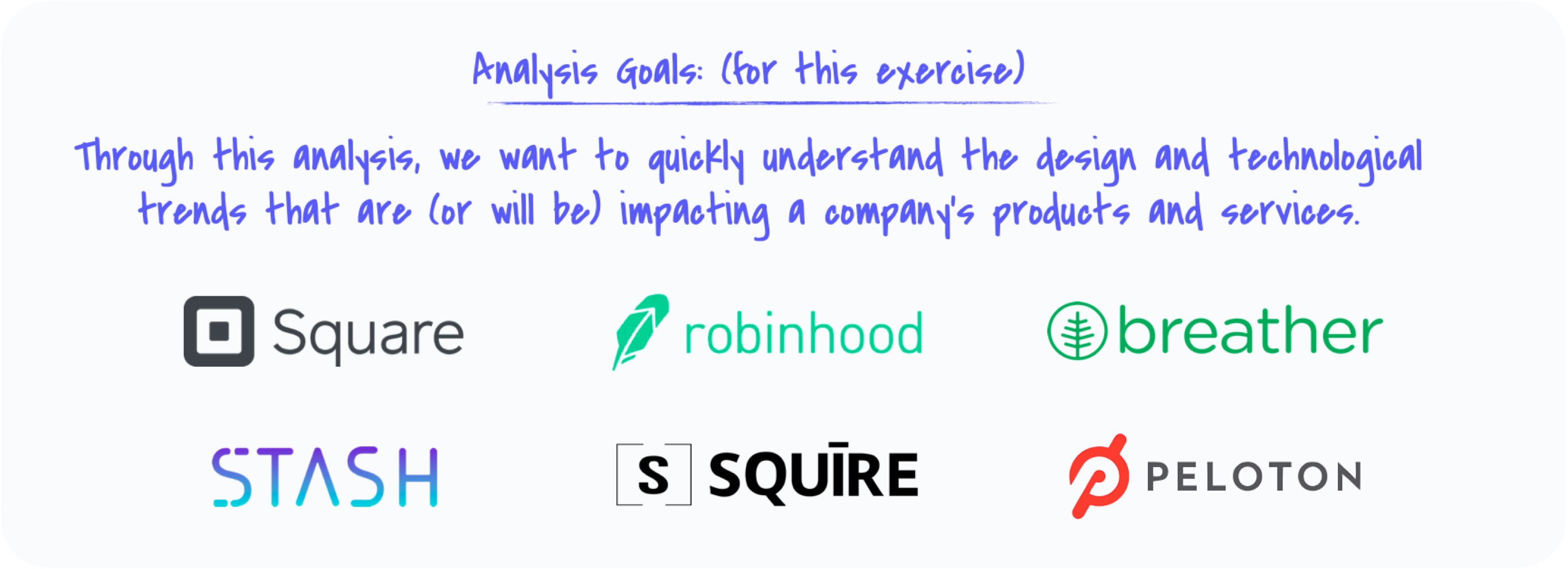
練習4:格式。 (Exercise 4: Format.)
After providing participants with an overview of Analysis Variable 04 (analyzing trends) and walking them through a real-world example of how they can start small to get up and running quickly, ask participants to practice conducting their own lightweight analysis.
向參與者提供了分析變量04的概述(分析趨勢),并引導他們完成了一個如何從小處著手以快速啟動并快速運行的真實示例之后,請參與者練習進行自己的輕量級分析。
Using the sample analysis goal (above), the free trend resources provided (below), and any relevant insights from previous activities, prompt participants to identify design and technological trends that are impacting a company or it’s products and services.
使用樣本分析目標(上) ,提供的免費趨勢資源(下)以及先前活動的任何相關見解,可以促使參與者識別影響公司或其產品和服務的設計和技術趨勢。
Pro-tip: Start with the free trends reports from Fjord and frog that we discussed earlier.
專家提示:從我們前面討論的Fjord和frog的免費趨勢報告開始。
- As participants identify trends, have them write each one on a separate post-it note. 當參與者識別趨勢時,讓他們在單獨的便條紙上寫下每個趨勢。
- As they work, remind participants to use what they learned in their previous analysis to identify which trends are relevant to the products and services of the company they are focused on. 在工作時,提醒參與者使用他們在以前的分析中學到的知識,以確定哪些趨勢與他們所關注的公司的產品和服務相關。
- To facilitate this, prompt participants using provocations — How modern and tech-forward is the company today? Which of the companies products could benefit from external advances in technology? Which of the companies products could be disrupted by upstart competitors? Why? 為方便起見,請挑釁者使用挑釁行為-今天的公司有多現代和技術進步? 哪些公司的產品可以從外部技術進步中受益? 新貴競爭對手可能會破壞哪些公司的產品? 為什么?
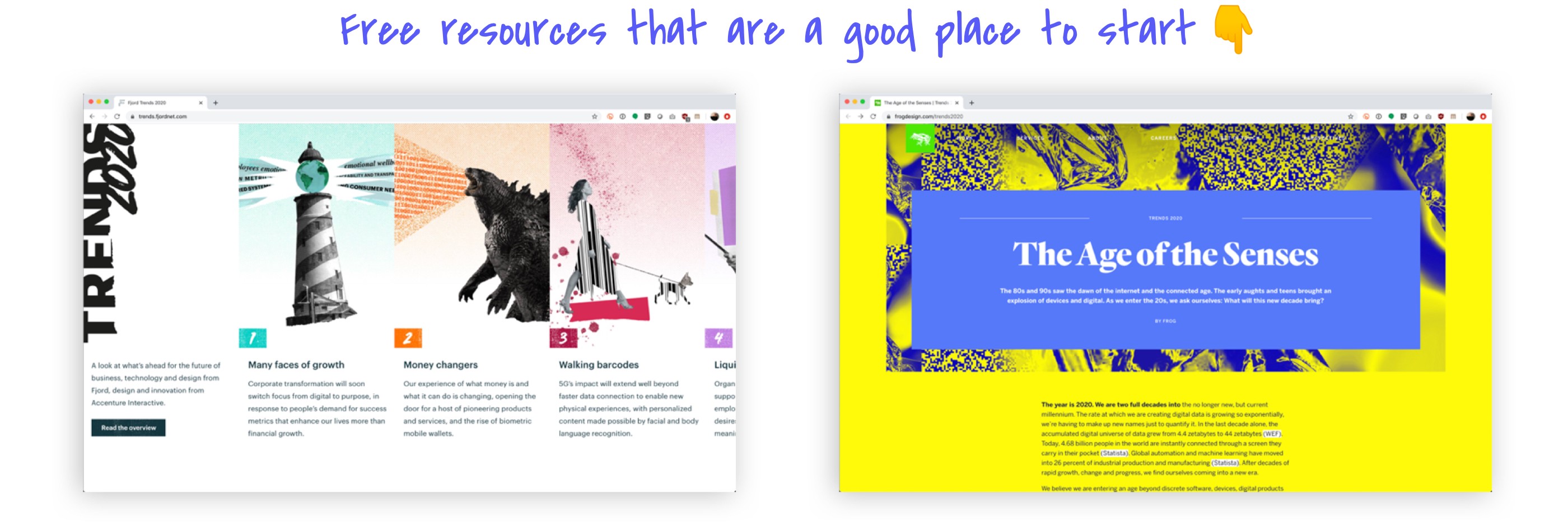
練習4:總結。 (Exercise 4: Wrapping-up.)
After the exercise, prompt participants to spend a few minutes sharing what they learned from conducting their analysis and what (if anything) was challenging about finding, analyzing, and relating information found in trends reports.
練習后,提示參與者花幾分鐘時間分享他們從進行分析中學到的知識,以及發現,分析和關聯趨勢報告中的信息所面臨的挑戰(如果有的話) 。

資源:中小企業面試指南 (Resources: SME interview discussion guide)
The shared resource below can be used as reference when you and your team are planning and conducting a technology-focused subject matter expert (SME) interview.
當您和您的團隊計劃并進行以技術為重點的主題專家(SME)面試時,下面的共享資源可用作參考。
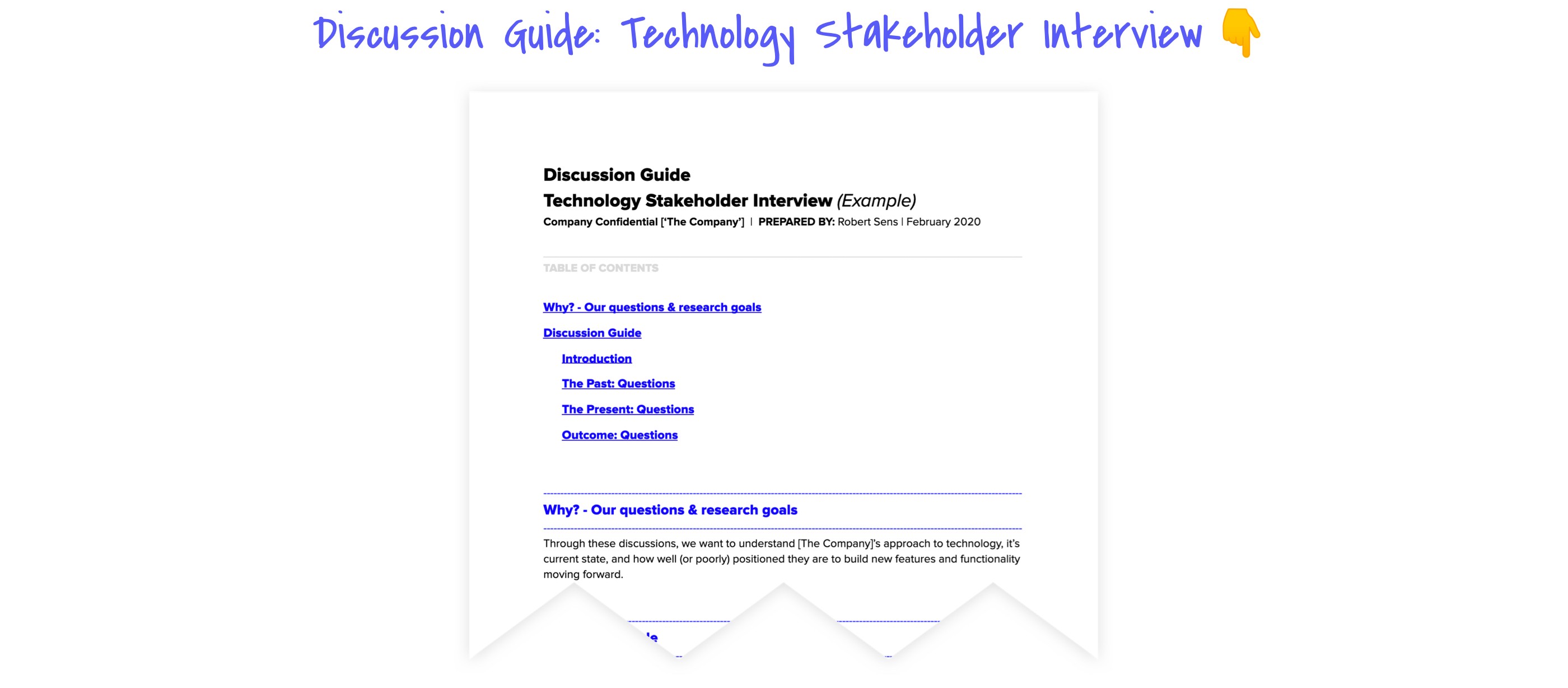
模板01: 討論指南-技術利益相關者訪談 (Template 01: Discussion guide — technology stakeholder interview)
Editable Google Doc and real-world example that you can use to help plan and facilitate an in-person (or remote) moderated subject matter expert (SME) interview.
您可以使用可編輯的Google Doc和真實示例來幫助計劃和促進親自(或遠程)主持的主題專家(SME)面試。
View and download example & editable template
查看和下載示例和可編輯模板

本系列的下一期是什么? (What’s the next session in this series?)
This session is the last session in this curriculum that is specifically focused on user research & customer discovery. Subsequent sessions focus on techniques for using what we have learned about customer behavior to develop and evaluate ideas — specifically synthesis, sense making, ideation, & evaluation.
本節課是本課程中的最后一節,專門針對用戶研究和客戶發現 。 隨后的會議重點討論了利用我們對客戶行為學到的知識來發展和評估想法的技術,特別是綜合,理性,構想和評估 。
For additional information on these sessions, please visit: 👇👇🏼👇🏾
有關這些會議的更多信息,請訪問: 👇👇🏼👇🏾

下一步是什么? (What’s next?)
Thank you for reading! Over the next few months, I will continue to add detailed session plans for each of the sessions outlined in this curriculum. In the meantime, any and all feedback is appreciated. 💭
感謝您的閱讀! 在接下來的幾個月中,我將繼續為本課程中概述的每個課程添加詳細的課程計劃。 同時,感謝所有反饋。 💭
翻譯自: https://blog.prototypr.io/ux-design-101-uncovering-your-clients-unspoken-needs-360-landscape-analysis-c9ff06a010ba
ux設計
本文來自互聯網用戶投稿,該文觀點僅代表作者本人,不代表本站立場。本站僅提供信息存儲空間服務,不擁有所有權,不承擔相關法律責任。 如若轉載,請注明出處:http://www.pswp.cn/news/274165.shtml 繁體地址,請注明出處:http://hk.pswp.cn/news/274165.shtml 英文地址,請注明出處:http://en.pswp.cn/news/274165.shtml
如若內容造成侵權/違法違規/事實不符,請聯系多彩編程網進行投訴反饋email:809451989@qq.com,一經查實,立即刪除!





)











—從圖片中獲得配色靈感)
